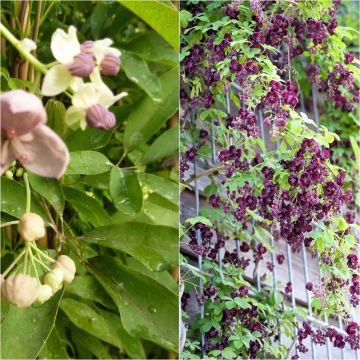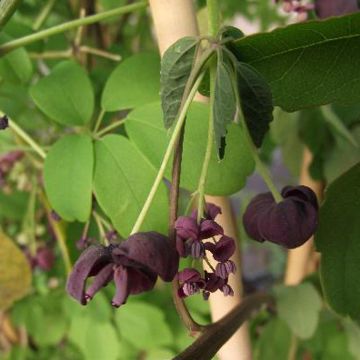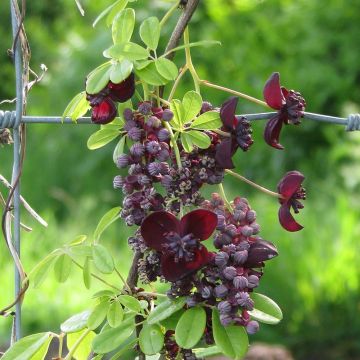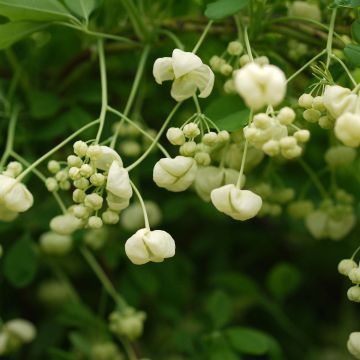
Akebia: planting, pruning and maintaining
Contents
Akebia in a nutshell
- Akebia is a voluble climbing plant with early purple flowering.
- Its graphic, exotic foliage is deciduous to semi-evergreen.
- It thrives ideally in partial shade but tolerates non-burning sunlight.
- Easy to care for and exuberant, it is perfect for quickly dressing a wall, pergola, or tree.
- Very vigorous, it allows light to pass through and does not suffocate the plants that welcome it.
A word from our expert
Less temperamental than a clematis and as voluble as a wisteria, Akebia quinata, commonly known as Akebia or “Chocolate vine”, is a climbing plant that is little known and originates from Asia. It is full of resources to wrap around anything within its reach: it climbs and, in no time, transforms the dreariest wall into a lush tableau.
Easy to cultivate and low-maintenance, Akebia quinata, like the hybrid Akebia x pentaphylla, offers a generous and early flowering from April to May. The numerous flowers, with a vanilla scent, emerge in original bell shapes, opening wide to reveal a dark pink hue ranging from purplish violet to wine red, with creamy white.
But that’s not its only asset! Depending on the varieties, its elegant foliage remains semi-evergreen in the favour of a mild winter.
If several plants are planted side by side, it produces strange, bluish, edible fruits that open when ripe. Its lush foliage and tolerance to nearly all exposures allow it to be used widely in the garden, particularly alongside another climbing plant such as a rose, a honeysuckle, or a clematis.
This voluble liana with exotic looks is ideal for dressing walls, pergolas, and fences, or for climbing up a tree. Once well established on a support tailored to its needs, this lovely exuberant can reach 5 to 8 metres in three to five years. Hardy, it withstands cold down to -15 °C.
Decorative and easy-going, this beautiful climbing plant, still little cultivated in gardens, captivates us with its originality!
Botany
Botanical data
- Latin name Akebia
- Family Lardizabalaceae
- Common name Akebia, Akebie, Chocolate vine
- Flowering April to May, fragrant
- Height 3 to 8 metres
- Exposure sun, partial shade
- Soil type Heather (Acidic), neutral
- Hardiness -15°C
Originating from the temperate forests of Japan, Korea, or China, Akebia, also known as “Chocolate vine”, belongs to the little-known family of Lardizabalaceae, like Stauntonias or Holboellias. It can be found in thickets and forest edges at altitude.
Akebia was introduced to Europe in the mid-19th century, where it became very popular. Once abundant, it has become rare, but Akebia is making a strong comeback today. This genus includes 4 species: Akebia quinata (Five-leaf Akebia), the type species, is the most appreciated of the genus with its clusters of purple flowers, Akebia trifoliata (Three-leaf Akebia), which is rarely planted, Akebia x pentaphylla (Hybrid Akebia), and the rarest, Akebia longeracemosa (Long-cluster Akebia).
Mature in three years, this vigorous woody plant is climbing: its stems cling to supports by wrapping around them. It quickly forms a vine of 6 to 10 metres in all directions, ideal for covering a fence or a tree. Exuberant, it can grow several metres in a single season. In less favourable conditions, it may take up to 5 years before it really starts. Its adult development covers 6 to 8 m²: like all vines, its stems wrap around large plants (trees, bushes) to conquer the heights and reach the light. Less vigorous than a Wisteria, its stems do not damage the supports they colonise. However, ensure it has a location where it can be easily contained and provide a support that is large and sturdy enough.
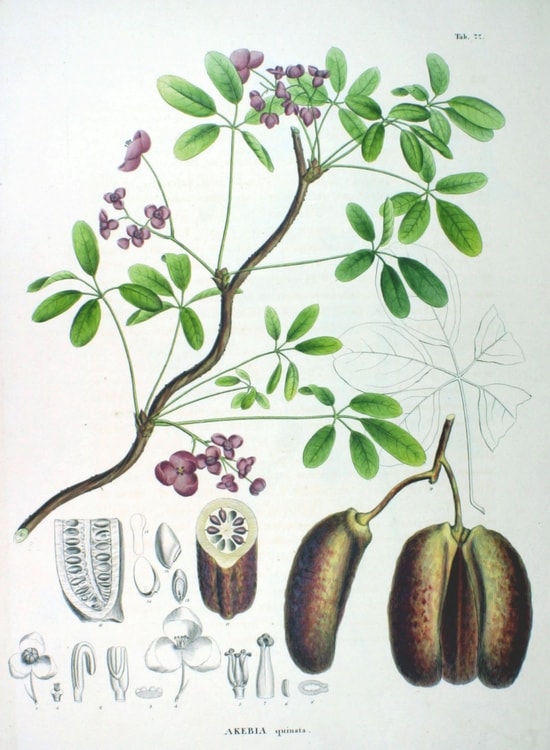
Akebia quinata: botanical illustration
Akebia produces very distinctive flowers, remarkable for their originality and delicacy. Early, its flowering occurs from mid-April to May. It takes place on the shoots of the previous year. Akebia bears beautiful drooping clusters of 8 – 12 cm long, adorned with bell-shaped flowers. In narrow cups, each flower is made up of three shell-like petals, ranging in colour from burgundy red to soft pink, cream to purple, and featuring 6 upright stamens that are chocolate to pink. Some varieties, such as Akebia quinata ‘Silver Bells’, bear bicoloured flowers, pale mauve and silver white, which are very original. This cheerful and nectariferous flowering exudes a light vanilla fragrance. Remarkably generous, it lasts 3 weeks to 1 month.
A monoecious plant, Akebia bears male and female flowers on the same plant. The female flowers are larger, fleshy, and darker in colour: they are the ones that form fruits if spring and summer have been warm enough. However, the plant is not self-fertile and requires the close presence of a second plant. It is necessary to associate at least two different varieties to ensure cross-pollination and thus obtain fruits.
In September-October, fleshy and pruinose fruits appear only with a warm spring and summer and on female subjects that have been fertilised. They take on an unusual shape of fleshy, curved cucumbers, 5 to 8 cm long, blue lilac or purple. When the fruit is ripe, it opens to reveal its large black seeds. Hanging at the ends of the branches, these edible fruits are harvested when they begin to open (in September or October) but are mainly of ornamental interest. Indeed, their translucent pulp is rather bland, although its taste, very sweet, is close to that of an apple.
We advise you to collect these rare fruits and destroy them to prevent the vine from becoming invasive by reseeding in nature. Akebia quinata is considered invasive in several states in the USA and in southern Great Britain. Fortunately, its mode of propagation is mainly vegetative (by layering) because, ultimately, fruiting is quite rare, especially in cold climates.
Akebia is a very “endearing” plant as it easily clings by wrapping its stem around its supports.
Round, green when young and then brown at maturity, these stems form an interlacing of fine and thin branches bearing a luxuriant and very decorative foliage. Graphical, it blooms lightly, serving as a backdrop for the flowers. Its compound, alternate, palmate leaves are divided into three to five obovate-elliptical leaflets, bright green in spring, bluish on the underside, turning purplish red in autumn.
Deciduous, its foliage can sometimes be semi-evergreen during mild winters: a significant advantage when one wishes to hide an unsightly wall.
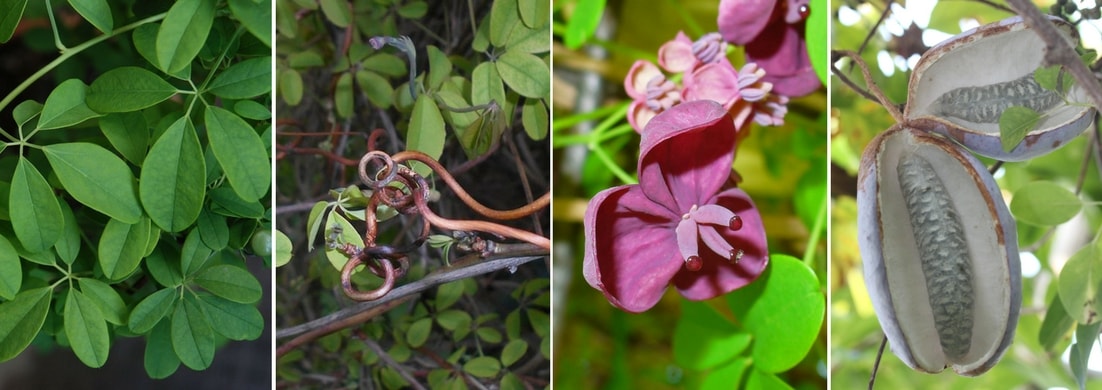
Foliage, stem, flowers and fruits
Easy to care for, Akebia is a temperate climate plant that can be grown anywhere, including in urban areas. Not very frost-sensitive, with excellent hardiness, it withstands frosts of around -13°C to -18°C for adult subjects. However, from -8°C, its leaves may suffer from the cold: they will fall, but the plant will regrow.
Akebia is one of the few climbing plants that accept shaded situations. But its tolerance to almost all exposures allows it to be used widely in the garden. In its natural habitat, it grows in shaded and dense wooded areas with little or no light. The ideal is to plant the base in shade and cool (but not wet) and the top in the sun, sheltered from cold winds to preserve its early flowering as the last frosts could damage its flowers. We recommend planting Akebia more to the East, so that the plant benefits from morning sun. It tolerates sunny exposure (except in southern regions) as long as the soil remains sufficiently cool, protected by good mulch in summer.
While Akebia is not fussy about soil type and is content with good neutral or slightly acidic garden soil, it prefers light, fertile, cool, and well-drained soils. Once well established, this vine can withstand occasional droughts. Its shallow root system allows it to be planted almost anywhere.
Akebia needs space and a support tailored to its size to thrive. It clings with its voluble stems and can be installed on a pergola, trellis, on a wall guided by wires or in a tree alongside a climbing rose or a Honeysuckle shrub, or a Clematis, whose flowering will take over. It is perfect for hiding an unsightly wall. Perennials can be planted at its base (Columbine, Schizostylis, Lysimachia…) to maintain some coolness at the root level.
Read also
When and how to prune Akebia?Species and main varieties
This genus includes four climbing species, but we mainly cultivate Akebia quinata (five-leaf akebia), the type species and also the most well-known of the genus with its clusters of purple flowers, Akebia x pentaphylla (hybrid akebia), and Akebia trifoliata (three-leaf akebia). There are many cultivars with white flowering such as Akebia quinata ‘Cream Form’ or variegated foliage Akebia quinata ‘variegata’, and pink flowers Akebia quinata var. ‘Rosea’. The main selection criterion is the flower colour.
The most popular
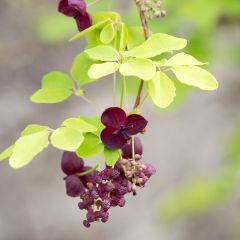
Akebia quinata - Chocolate Vine
- Flowering time May, June
- Height at maturity 9 m
- Akebia trifoliata or three-leaf akebia: features chocolate flowers that stand out against the bronze foliage when young, then dark green. This climber is slightly less vigorous than A. quinata and A. × pentaphylla. Its purple fruits are smaller than those of Akebia × pentaphylla.
Our favourites
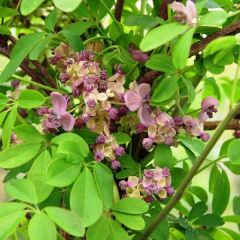
Akebia quinata Silver Bells
- Flowering time May, June
- Height at maturity 6 m
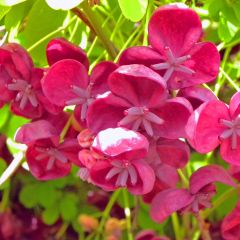
Akebia quinata var. Rosea
- Flowering time May, June
- Height at maturity 6 m
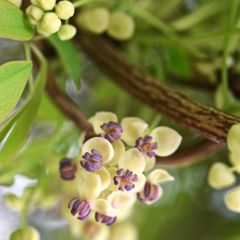
Akebia quinata Akebia Cream Form
- Flowering time May, June
- Height at maturity 8 m
Other interesting varieties
- Akebia quinata ‘Alba’ with white flowers and pink stamens.
- Akebia quinata ‘Amethyst Glow’ with red flowering.
- ‘Purple Bouquet’ for its dark purple flowers and its more compact and darker foliage than the type species.
- Akebia quinata ‘Bookside Variegata’: the same characteristics as the type species but with leaves variegated with white-yellow.
Discover other Akebias
View all →Available in 0 sizes
Available in 2 sizes
Available in 1 sizes
Available in 1 sizes
Available in 1 sizes
Available in 1 sizes
Available in 1 sizes
Available in 2 sizes
Young plantation
Where to plant Akebia?
Easy to grow, Akebia is a plant suited to temperate climates that can be cultivated anywhere, including urban areas. Hardy (with Akebia pentaphylla being the least hardy of its species), it can withstand temperatures around -15 °C, sometimes even lower in sheltered situations and if its base is well mulched. Late frosts can cause damage to young shoots.
Sun, partial shade, and even shaded situations: its tolerance to almost all exposures allows for extensive use in the garden, provided it is sheltered from the wind. We recommend planting it preferably in partial shade, especially in warm regions and preferably to the east, so that the plant can benefit from morning sunlight.
Its shallow root system allows it to be installed almost anywhere. Very tolerant of soil type, it is satisfied with good neutral or slightly acidic garden soil, although it prefers light, cool, dry, and well-drained soils that will ensure optimal growth. Once established, this liana can withstand occasional droughts. To protect it from summer heat, plant some perennial plants (Carex, Ophiopogon, Heucheras…) at its base to provide shade.
It is a vigorous plant that requires an airy location: its adult development covers 6 to 10 m², and it can be relatively invasive!
Akebia needs a support that matches its growth to spread well. A sturdy trellis is necessary. It easily clings with its voluble stems equipped with tendrils to various supports: pergolas, trellises, or to hide an unsightly wall. It can also climb around a tree or ascend a fence. It is a vigorous yet lightweight plant, not strangling nearby vegetation unlike Wisteria. However, ensure it has a location where it can be easily contained and carefully select the support it will rely on.
When to plant Akebia?
Akebia is planted in spring from March to May or preferably in autumn from September to November to enjoy its early flowering.
How to plant?
Once well established, Akebia requires little care. The secret to this vigorous climber lies in the planting.
In a hole measuring 50 cm by 50 cm, spread a layer of gravel to allow for good drainage and prevent moisture at the root level during the winter season. Mix organic fertiliser, a bit of potting soil, or heather soil with the extracted soil. Place the young plant and then fill the hole with the same mixture.
Train the first branches onto the support; afterwards, they will cling on their own. Plant perennial plants around the base to maintain freshness in summer or apply mulch with leaves, needles, or pine bark. Water but do not overwater.
Given its significant growth and rapid development, one plant per m² will suffice to cover 6 to 8 m² in a few years.
Maintenance and pruning
This beautiful woody plant requires little care. The branches easily wrap around supports. As with many climbing plants, at the start, help its stems to climb. Once well established, Akebia manages almost on its own. To protect it from frost, mulch the stump during the first winters, and in regions where winters are harsh. You can also mulch in summer to keep its base cool if you haven’t planted ground cover plants.
Each year, in spring, before the growth resumes, add compost. In summer, water only when the soil is dry several centimetres deep.
It is not known to have any pests or diseases.
→ Also read our advice sheet: How to grow an Akebia in a pot?
Pruning Akebia
With significant growth, Akebia tolerates shaping well. Maintenance is therefore limited to light pruning, always after flowering, to control its spread and to remove weak shoots.
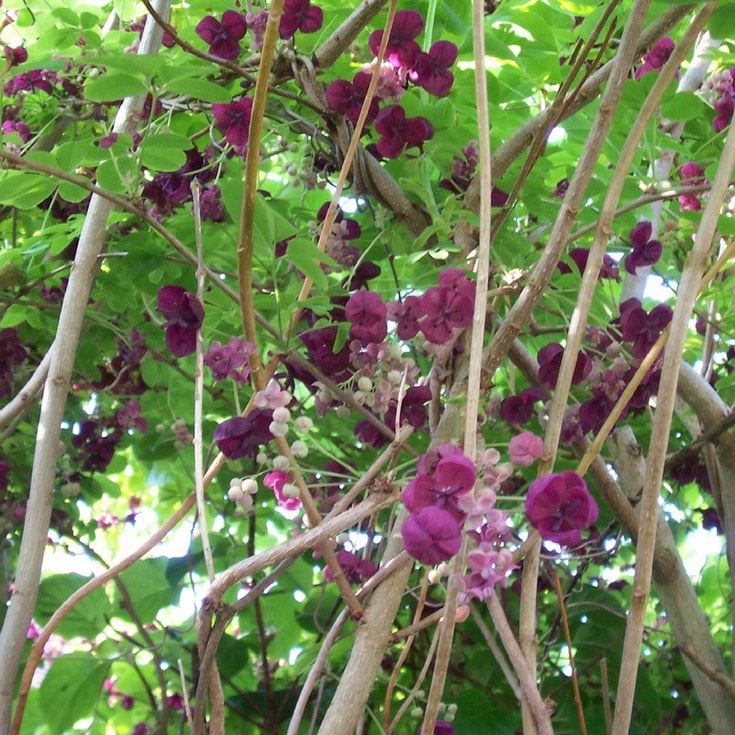
Akebia quinata – Photo Leonora Enking
There are solutions to limit its exuberance: it is better to avoid allowing the branches that crawl on the ground to develop, as they can root and spread the liana invasively. Akebia does not like drastic cuts, it does not always respond well to this type of pruning. You can cut back a particularly vigorous stem to ground level every two years.
→ Learn more about pruning Akebia in Gwenaëlle’s tutorial.
Which support to choose?
Akebia needs a support to grow, as its stems are not rigid enough to support its weight. Nevertheless, it clings to its support by itself; you just need to guide the shoots at the beginning, then the stems will wrap around it on their own. It can lean against a wall, wind around a tree, climb up a fence, or cling to a trellis. You will have the choice between wooden trellises (durable exotic woods require little maintenance), PVC, or steel, which are useful for these fast-growing plants that will eventually weigh down the trellis.
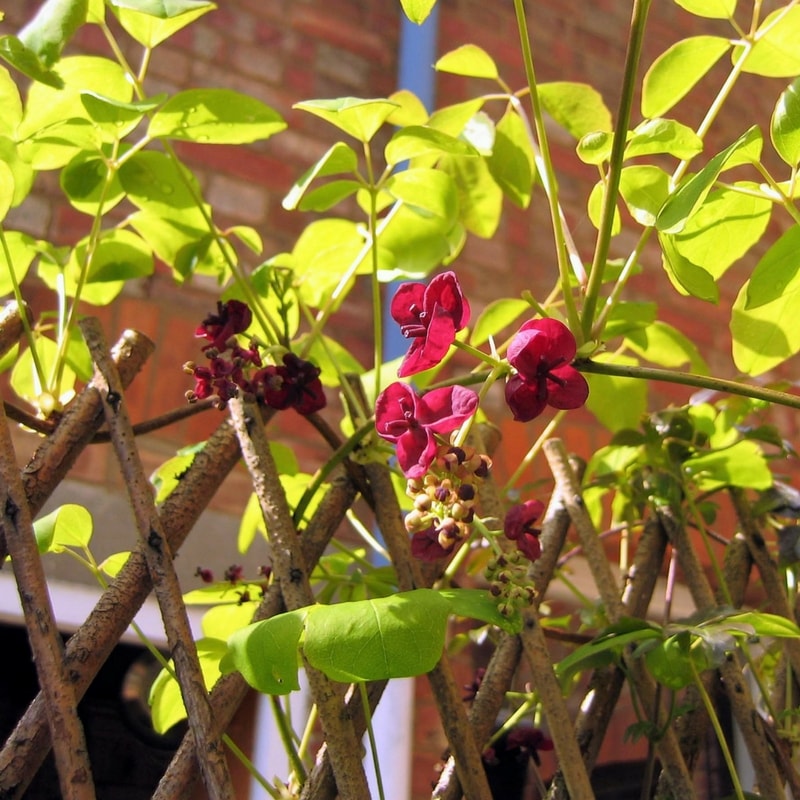
This trellis is very pretty but it may not be strong enough to support the weight of the Akebia once it is mature
Multiplication
By propagation by cuttings
This is the simplest and least tedious method to multiply Akebia. In August-September, take semi-woody or semi-hardwood cuttings of 10 to 20 cm, depending on the size of the Akebia being propagated (that is, from stems that have grown in spring and begin their transformation from softwood to hardwood from July-August). Cut a healthy shoot from the current year at an angle, just below an eye. Plant them in a light, well-draining substrate. Regularly mist the cutting with a spray bottle. Transplant them into buckets as soon as they have formed roots. Winter them in a frost-free environment, under a cold frame or shelter. Plant them in the ground the following spring.
→ Learn more in our tutorial How to propagate Akebia?
By layering
At the end of autumn, layer one of its lianas by bending it towards the ground, burying part of it to encourage rooting. Support the aerial part. In spring, you can separate the layer from the mother plant if it has enough roots. Otherwise, wait until the end of summer to cut the stem at the point where it goes into the ground.
Useful resources
- The most beautiful range of Akebia is with us!
- Get inspired to dress your walls and pergolas with an original climbing plant!
- Akebia and its edible fruits: an unknown treasure
- Our tutorial: How to train Akebia in the garden?
- Diseases and parasites of Akebia: our tips for caring for it
- Subscribe!
- Contents
































